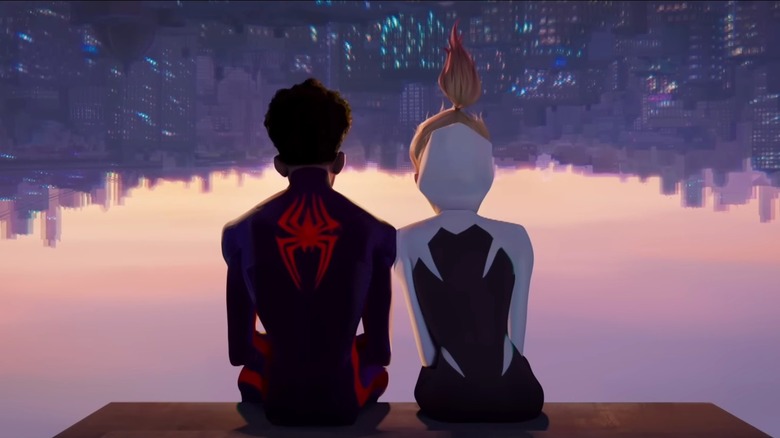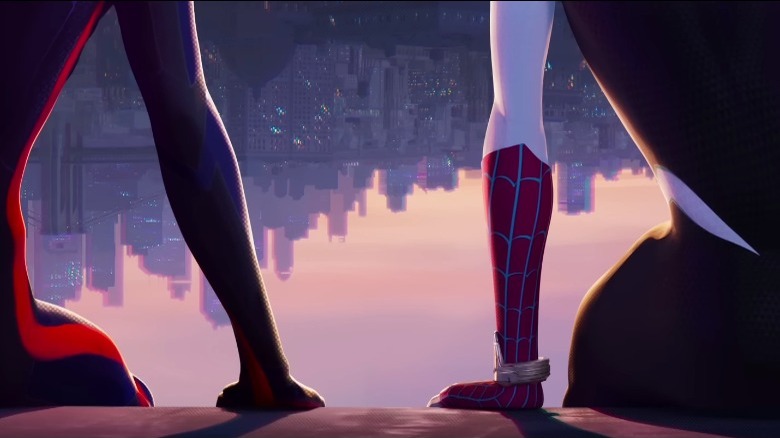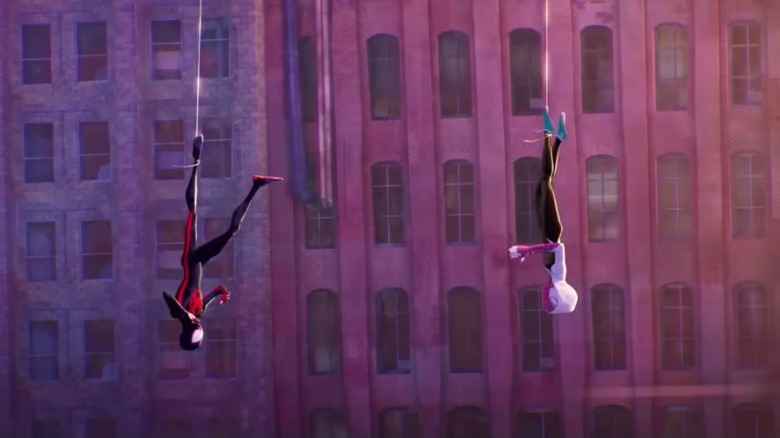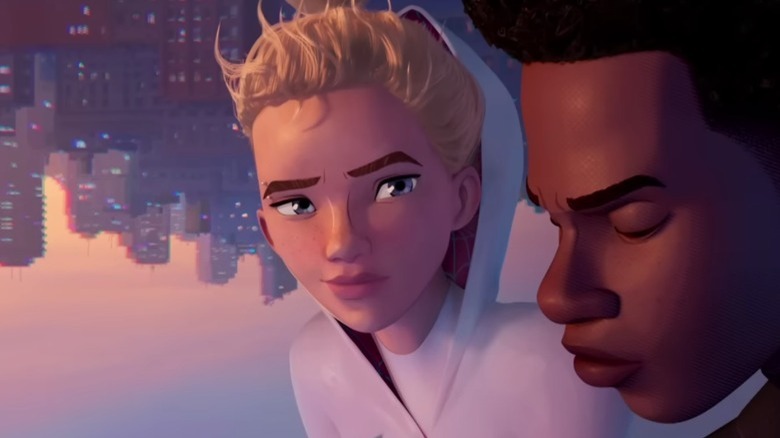One Of Across The Spider-Verse's Best Scenes Sparked A Funny Chat About Spider-People Butts
This article contains spoilers for "Spider-Man: Across the Spider-Verse."
"Spider-Man: Into the Spider-Verse" is chock full of impressively animated scenes, but none left audiences as collectively breathless as the moment in which Miles Morales (Shameik Moore) took a stunning nosedive off a skyscraper, making a literal leap of faith that gave the world chills. While there might not be a frontrunner scene in "Spider-Man: Across the Spider-Verse" that had the same universally mind-blowing effect, I know which one left me the most in awe. Early in the film, when Gwen Stacy (Hailee Steinfeld) stepped off the edge of Brooklyn's Williamsburg Bank building, I was so dazzled by the moment when the world shifted around her to accommodate her upside-down perspective, I almost cried.
The whole sequence is golden. In it, Gwen and Miles sit side-by-side upside down, sharing a moment that's friendly, romantic, and wistful in turn. The animation is impressive to a degree that's almost hard to comprehend, and while the scene itself is quiet and emotional, it's also just as astonishing as any of the movie's flashier sequences. The team behind the movie went long on the process of making this scene in the new book "Spider-Man: Across the Spider-Verse: The Art of the Movie," and in between making insightful comments about the tone, details, and setting of the scene, they addressed one detail that audiences might have been wondering about: how are these two even sitting upside down in the first place?!
The upside-down scene inspired some logistical questions
Co-writer Christopher Miller doesn't actually explain the gravity-defying miracle of the scene, but he did tell author Ramin Zahed that conversations about it came up. "There were lots of discussions about whether their spider-butts are sticky. How does this work exactly?" Miller apparently said with a laugh. The science behind Spider-Man's sometimes-sticky suit hasn't always been consistent, but in most versions of the story — including, memorably, the Tobey Maguire-led film trilogy — Spider-People are able to cling to surfaces thanks to tiny, sharp hairs much like those real-life spiders use to scurry across walls and ceilings. In theory, Spider-People could have those hairs all over, but in Spider-Man movies, they tend to only stick to surfaces with their hands and feet.
Ultimately, Miller implied that the stickiness (or lack thereof) of Spider-People derrieres is not as integral as the emotional truth of the scene — and the phenomenal visuals it pulls off. "What was important was that you can only do this in a movie like this and enjoy the sunset in a way that you've never seen before!" he said in the new book. "Ultimately, we ended up with this moment that has a hint of wistfulness," Miller added, noting that the scene ends up loaded with regret over the limitations of their relationship, which is pretty much destined to be doomed by "forces in the universe that don't allow it to become anything more than what they have in this moment."
How animators brought the Gwen and Miles moment to life
We may never know exactly how exactly Gwen and Miles didn't fall off their upside-down seat (honestly, if I had superglue-like butt technology I wouldn't be advertising it in my new powers montage either), but the team was certainly forthcoming about how animators pulled off the brilliant quasi-first date sequence. Visual effects supervisor Mike Lasker said that animators "had to build this couch-like seat" for the young lovebirds, "right on the underside of the ledge." He adds that the shot included some twinkling lights signifying the world carrying on down below. "We played with lights and shadows and kept the city a little bit alive beneath them, with subtle sirens and light flashes here and there," Lasker shared.
Production designer Patrick O'Keefe also explained that the scene was meant to feel especially comfortable for Miles, as it took place in his hometown of Brooklyn, New York. "We have this iconic structure which towers over Brooklyn and also serves a quiet spot for Miles that only he can get to," O'Keefe shared in the book. "It's a space that is very comforting to him, so when it came to the lighting, It was much about that very precious, short-lived moment in the day where we're getting ready to transition into the evening." The scene takes place during that golden hour when, as O'Keefe put it, you can witness "the quiet beauty of those moments as the city transitions into evening."
A subtle, sensitive moment
O'Keefe also highlighted the work of artist Peter Chan, who worked on "Spider-Man: Into the Spider-Verse" and returned for the sequel. "Peter is an artist that we traditionally use for the most colorful scenes possible because he has this ability to handle a wide variety of colors," O'Keefe noted, but in this scene, he asked Chan to limit his color palette and "pay very close attention to the sensitivity of the sequence." That sensitivity definitely comes through in the finished film. It's a scene that's clearly not just about love in a romantic sense, but also loneliness, friendship, and the pain and exhilaration of growing up.
"There are lots of lots of very subtle, but huge shifts happening here," O'Keefe pointed out. "Although it feels magical and romantic, it's not telling you directly. The visuals are letting you feel the romanticism of the moment quietly." It's true; the old cliche states that a picture is worth a thousand words, but the shots here seem to express even more than that and manage to do it all while leaving us speechless. This is good because if we did speak up, we'd probably end up asking a geeky, technical question about Spider-People anatomy that would ruin the moment.
"Spider-Man: Across the Spider-Verse" is now in theaters. "Spider-Man: Across the Spider-Verse: The Art of the Movie" hits bookstore shelves today.



